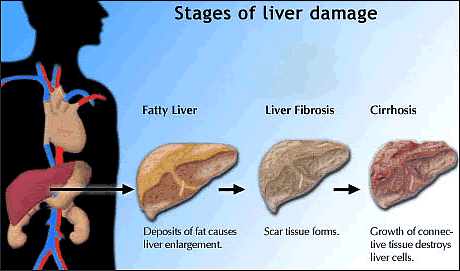Rapid
Liver Disease Progression among HIV Positive Men with Acute Hepatitis
C Coinfection
 |
 |
 |
 |
 |
|
| SUMMARY:
People who already have HIV when they become infected with
hepatitis C virus (HCV) may experience very rapid liver disease
progression, researchers from Mt. Sinai Medical Center reported
at the American Association for the Study of Liver Diseases
"Liver Meeting" (AASLD 2010)
held recently in Boston. A detailed review of 4 coinfected
patients with persistent HCV viral load revealed progression
to decompensated cirrhosis over relatively short periods of
time, resulting in persistent symptoms, liver transplantation,
or liver-related death. |
|
|
 |
 |
 |
 |
By
Liz Highleyman
Since the early 2000s, clinicians in the U.K. and Europe have reported
clusters of apparently sexually transmitted acute HCV infection among
HIV positive gay and bisexual men, with similar cases later seen in
the U.S. and Australia. A considerable body of evidence indicates that
HIV/HCV coinfected people tend to experience more rapid liver disease
progression than individuals with HCV alone, especially if they have
low CD4 cell counts.

But
a subset of coinfected patients -- those with are already HIV positive
when they contract HCV -- may experience very aggressive liver disease
progression. Daniel Fierer and colleagues from Mt. Sinai in New York
City first
reported unexpectedly advanced liver disease in a cohort of HIV
positive men with short-term HCV infection at the 2007 Conference on
Retroviruses and Opportunistic Infection, and later in the September
1, 2008 Journal of Infectious Diseases.
Since then,
Fierer's group has continued to describe disease progression in this
cohort, on the basis of liver biopsy findings. Other groups, primarily
in Europe, have
not observed similar rapid progression, but they typically use the
non-invasive transient elastometry or Fibroscan method rather than biopsy,
which may underestimate liver damage.
At the recent AASLD meeting Fierer and colleagues presented a poster
describing 4 cases of rapid liver disease progression in detail. These
HIV positive men were initially diagnosed with new HCV infection, defined
as ALT elevation with detectable plasma HCV vial load; all had HCV genotype
1a. They went on to experience HCV antibody seroconversion and developed
chronic or persistent infection. Three were members of the Mt. Sinai
cohort of 14 coinfected patients with persistent detectable HCV for
at least 2 years, suggesting that "this phenomenon is not rare,"
the researchers said. The fourth man was from San Diego.
Patients' ages ranged from 39 to 54 years. CD4 cell counts were 53,
200, 381, and 442 cells/mm3. None of the men reported heavy alcohol
use, which can contribute to rapid liver damage.
Most HIV
patients diagnosed with acute hepatitis C at Mt. Sinai undergo treatment
with pegylated interferon
plus ribavirin and achieve sustained virological response, or a
cure. Of the 4 cases described here, however, 2 refused treatment, 1
did not tolerate therapy and stopped after 1 dose, and 1 experienced
treatment failure. In the real world acute HCV infection is typically
not detected during the acute stage, so these cases may reflect what
usually happens when HCV infection occurs on top of HIV.
Fibrosis
was staged according to the Scheuer system, with 0 indicating absent
fibrosis and 4 indicating cirrhosis. Three of the described patients
had stage 3 fibrosis when first biopsied and progressed to stage 4 by
the second biopsy; the remaining man had stage 2 fibrosis at first biopsy
and did not receive a second test. All 4 men progressed to decompensated
cirrhosis within 14 months to 6.5 years after ALT elevation was first
detected; among HCV monoinfected individuals, in contrast, this degree
of liver disease progression typically takes decades.
Decompensation means the liver can no longer carry out its normal functions.
Impaired blood flow through the increasingly damaged organ can cause
portal hypertension, or increased pressure in the portal vein, leading
to symptoms such as bleeding varicose veins in the esophagus and ascites,
or accumulation of fluid in the abdomen.
None of the 4 men had nodular regenerative hyperplasia or hepatoportal
sclerosis (2 other possible causes of portal hypertension in the absent
of significant fibrosis); 2 had mild-to-moderate steatohepatitis, or
fat accumulation in the liver along with inflammation. The researchers
said the patients did not have pathology suggesting liver toxicity from
antiretroviral drugs such as stavudine
(d4T, Zerit) or didanosine
(ddI, Videx). Serial imaging showed progression from mildly abnormal
livers to small nodular livers in all patients.
The 4 patients continued to experience rapid clinical disease progression
after developing decompensated cirrhosis. One man underwent liver transplantation
2 years after initial HCV diagnosis, another was still alive but with
persistent ascites after 6.5 years, and 2 died of liver failure at 2.75
and 7 years.
These 4 cases show that "early onset fibrosis after HCV infection
of HIV-infected men is not benign, does not spontaneously resolve, and
can quickly progress to cirrhosis, liver failure, and death," the
researchers concluded.
Progression may be more rapid in people with AIDS (CD4 cell count <
200 cells/mm3), "but even those with well-controlled HIV infection
progress far more rapidly than expected," they added. "It
is therefore essential to identify, treat, and cure all HIV-infected
men with new HCV infection to prevent these dire outcomes."
Investigator affiliations: Departments of Medicine and Pathology,
Mount Sinai School of Medicine, New York, NY; Weill Cornell Medical
College, New York, NY; St. Vincent's Medical Center, New York, NY; University
of California, San Diego, CA; VA Medical Center, San Diego, CA.
11/9/10
Reference
D Fierer, D Dieterich, MI Fiel, and others. Rapid Progression to
Decompensated Cirrhosis and Death in HIV-infected Men with Newly-acquired
HCV Infection. 61st Annual Meeting of the American Association for the
Study of Liver Diseases (AASLD 2010). Boston, October 29-November 2,
2010. Abstract 879.